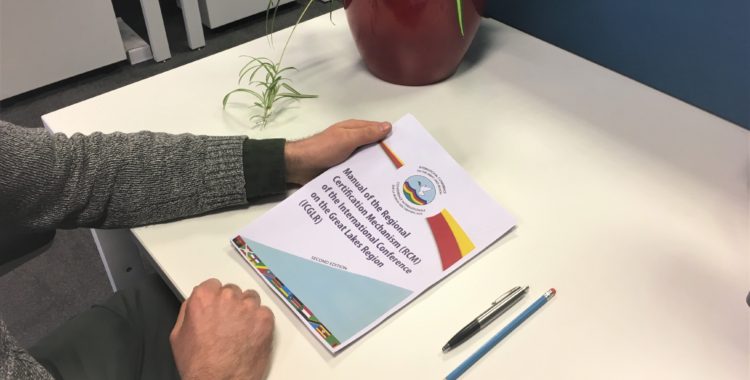This short technical blog series has been developed to help you understand what Regional Certification Manual (RCM) elements have changed, why they were changed, what this means in practice and how the changes represent a significant improvement. The blog series is for anyone with an interest in certifying responsible supply chains in the African Great Lakes Region, and may also be of relevance to other Conflict Affected and High-Risk Areas (CAHRAs). More specifically, it will be of practical value to public institutions (especially mineral producing and mineral importing countries), private sector actors (from producers to traders, exporters, smelters, refiners and end users) and civil society actors / practitioners engaged in the responsible trade of minerals. The series will offer insights that enhance your understanding of the new RCM manual in a time-effective manner.
These blogs mark the publication and entry into force of the Second Edition of the RCM of the International Conference for the Great Lakes Region (ICGLR), in January 2020. Prepared by Adam Rolfe, Levin Sources, and Mike Loch, Responsible Trade, they provide the perspectives of two of the primary drafters and facilitators of the revision process.
What is the RCM and why was it revised?
The RCM of the International Conference of the Great Lakes Region (ICGLR) of central Africa is a regional standard to combat the illicit production and trade of tin, tantalum, tungsten and gold (3TGs), which has been linked to conflict and the perpetuation of gross human rights violations. Drawing on the OECD Due Diligence Guidance for Responsible Mineral Supply Chains, the RCM forms part of the Regional Initiative against the Illegal Exploitation of Natural Resources (RINR) and first entered into force in 2011. Despite some progress in implementation, notably in the Democratic Republic of Congo and Rwanda, and more recently in Burundi and Tanzania, the RCM remains only partially executed and weakly enforced. After 7 years of implementation it was therefore necessary to review and revise the standard with a view to ensuring greater uptake and impact in the years to come.
When and how was the RCM revised?
A comprehensive review and revision of the RCM was undertaken between January 2018 and October 2019, which led to some significant changes being made to the certification scheme.
The revision exercise was conducted by independent consultants from Levin Sources and Responsible Trade on behalf of the ICGLR, and was funded by German development cooperation.
All changes to the existing manual were made on the basis of an inclusive stakeholder consultation process and technical papers assessing the cost and impact of the manual to date. All modifications were further assessed against a list of criteria, developed at the beginning of the process. These were the requirement to:
- Contribute to increasing the credibility of the RCM
- Support implementation efforts and Member State ownership
- Reduce implementation costs
- Provide clarity to requirements of the standard
- Clarify the roles and responsibilities of actors
- Increase the efficiency of the mechanism
- Ensure greater alignment with the OECD due diligence guidance; and
- Provide for appropriate checks and balances
Input was received from international and regional stakeholders from government, industry and civil society, through workshops, information sessions and online consultation platforms.
All feedback and recommendations were compiled into a master matrix and subjected to a technical assessment, taking into account the key criteria.
The Second Edition of the manual went through a total of four iterations before being submitted to the ICGLR Regional Committee for review and validation in October 2019.
What are the main outcomes of the RCM revision process?
The Second Edition of the RCM has not fundamentally changed the purpose of the mechanism, which remains to contribute to, and certify, mineral supply chains that do not directly or indirectly provide support to non-state armed groups and / or public or private security forces, or contribute to serious human rights abuses (as outlined in Annex II of the OECD Due Diligence Guidance on Responsible Mineral Supply Chains).
The new manual does however introduce significant changes to the requirements, processes and roles and responsibilities of actors. We believe that these innovations will make the RCM more user-friendly, ensure widespread uptake in the years to come and strengthen enforcement by focusing on its fundamental elements.
This blog series will serve to provide an overview of the Second Edition of the RCM manual. It will introduce and describe the major changes and their significance:
- Blog 2: Keeping minerals from the GLR flowing: An introduction to “Blue Status” for Mine Sites and Exporters.
- Blog 3: Focussing on the fundamentals: Removal of “Progress Criteria”, Removal of the Independent Mineral Chain Auditor function.
- Blog 4: Other major changes.
Stay tuned for the next blog in the series and find out about the new Blue Status for mine sites and exporters and how this element in the RCM aligns with the OECD Due Diligence Guidance. We will describe what it means and how it helps ensure the flow of responsibly sourced minerals in start-up and low capacity situations – an essential ingredient for ensuring the commercial viability of formal mineral supply chains in the GLR.






